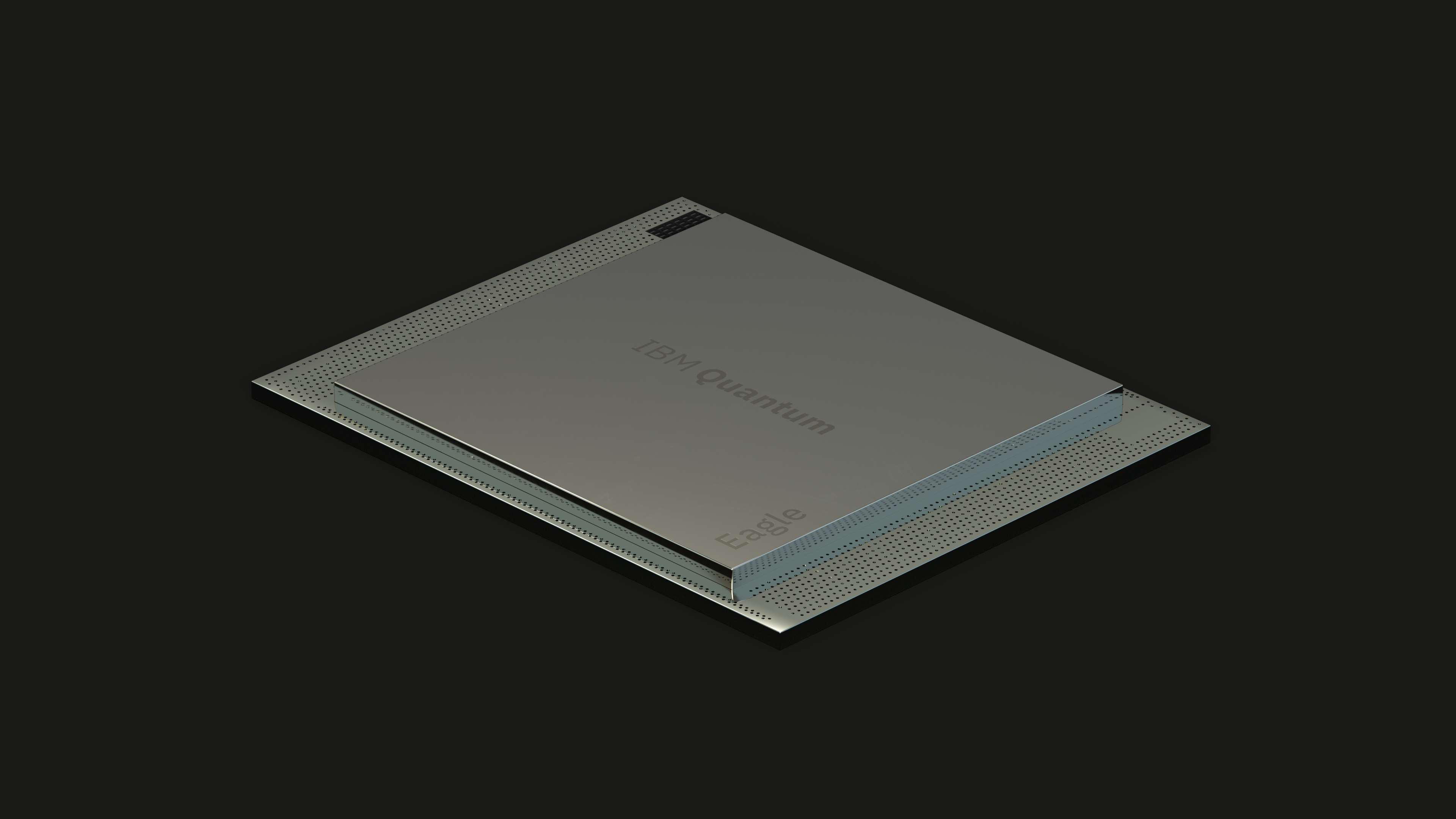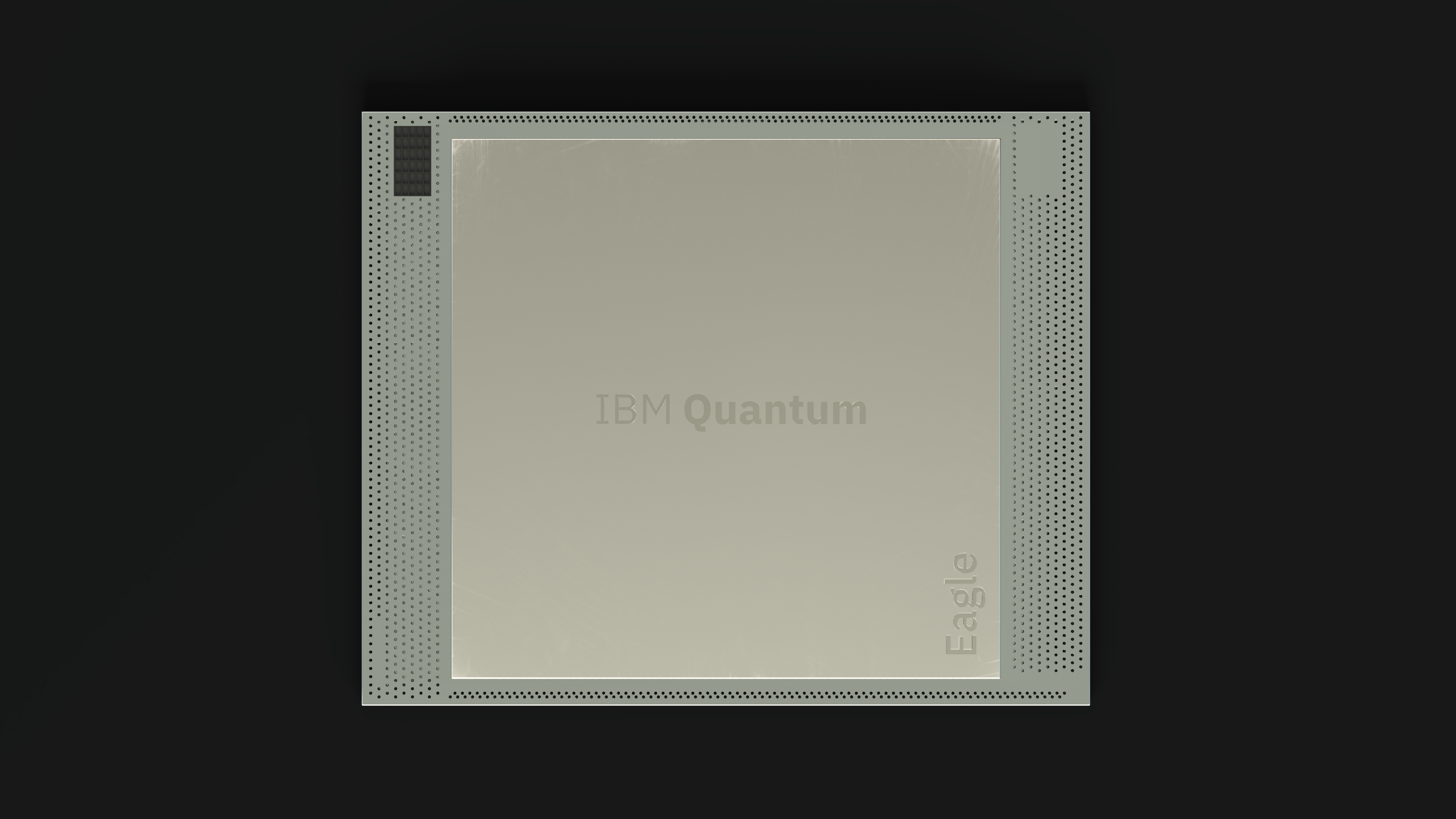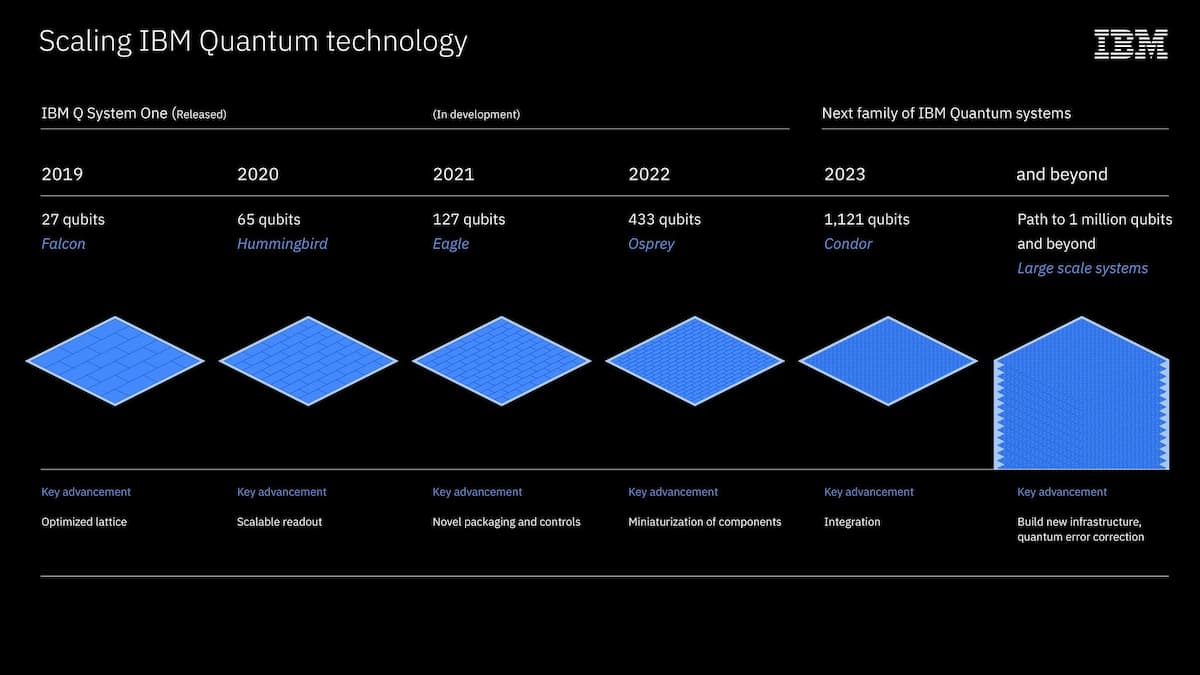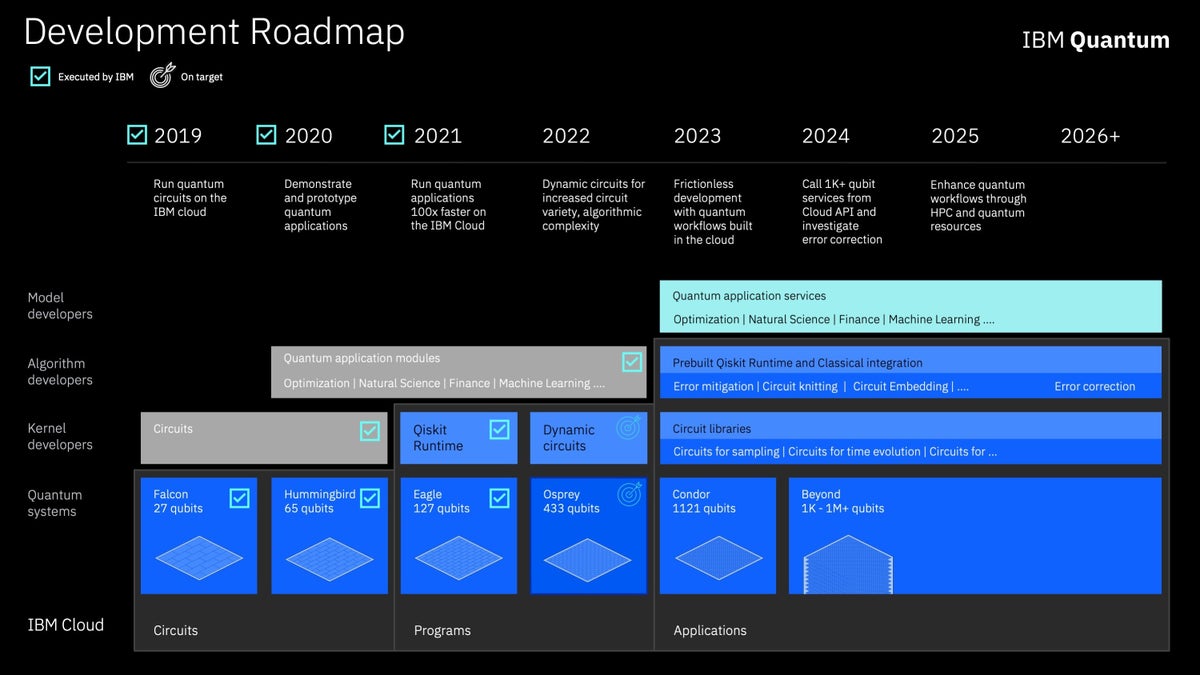IBM Announces 127-qubit “Eagle” Quantum Processor
IBM expects to achieve a 1,121-qubit quantum processor - and quantum advantage - by 2023.
At the annual Quantum Summit today, IBM upped the ante by announcing its latest quantum Processor, codenamed Eagle. The new quantum processor is the world’s first to feature more than 100 operational and connected qubits – 127, to be exact.
“The arrival of the ‘Eagle’ processor is a major step towards the day when quantum computers can outperform classical computers at meaningful levels,” said Dr. Darío Gil, Senior Vice President, IBM and Director of Research. “Quantum computing has the power to transform nearly every sector and help us tackle the biggest problems of our time. This is why IBM continues to rapidly innovate quantum hardware design, build ways for quantum and classical workloads to empower each other, and create a global ecosystem that is imperative to the adoption of quantum computing.”
Applications for quantum computing - now accelerated with IBM’s Eagle – can be found anywhere from machine learning optimizations; materials and molecule modelling (essentially covering almost all elements of life, from molecular gastronomy to engineering materials and substrates); to drug and energy industry research fields. There now exists a quantum computer that can solve computational problems no classical computing system can crack. At least, not before the Universe were to die out - twice over, in some cases. Unfortunately, the Eagle is still only available as an exploratory device on the IBM Cloud, via its IBM Quantum Network initiative.
IBM’s Eagle naturally builds upon design decisions from the company’s previous achievements. It follows the 65-qubit Hummingbird (2020) and the 27-qubit Falcon processor from 2019, and takes lessons learned from both those architectures to achieve even more complex quantum circuits than were ever possible before. While qubits can be looked at as the equivalent of your laptop’s cores, quantum circuits represent the way those cores are arranged – how they are divided into quantum gates and measurements.
The more qubits (cores) the system has, the more complex programs (quantum circuit layers) it can run. IBM says Eagle is so advanced that if you were to describe the quantum state of Eagle’s 127 qubits in a classical computer, you’d need more bits than atoms exist in all 7.5 billion people on Earth.

The 127-qubit Eagle quantum processor


IBM went into some additional detail on the design ethos for Eagle:
"We had to combine and improve upon techniques developed in previous generations of IBM Quantum processors in order to develop a processor architecture including advanced 3D packaging techniques that we're confident can form the backbone of processors up to and including our planned 1000+ qubit Condor processor. Eagle is based upon our heavy-hexagonal qubit layout as debuted with our Falcon processor, where qubits connect with either two or three neighbors as if sitting upon the edges and corners of tessellated hexagons. This particular connectivity decreased the potential for errors caused by interactions between neighboring qubits-providing significant boosts in yielding functional processors."
Get Tom's Hardware's best news and in-depth reviews, straight to your inbox.
To increase the number of qubits, IBM engineers had to find new ways to expand on the intricate balancing act between the three planes of quantum computing: scale, quality, and speed. Scale refers to the number of qubits present in any given system – and thus the complexity of available circuit layer operations. Quality refers to the number of qubits that can perform usable work, itself expressed via quantum volume. And finally, a quantum system's speed is given by its standardized CLOPs score, which IBM proposed as a performance standard not so long ago.
In order to reduce the number of elements that can interfere with quantum coherency, IBM made changes to qubit arrangements and reduced the number of necessary components for qubit control – any element that’s part of a quantum computing system inevitably contributes to unbalance the system. In order to reduce the impact of qubit control operations, IBM’s researchers have spread out control wiring throughout several layers of the Eagle quantum processor, whilst qubits remain on their own isolated layer – thus reducing destabilization of the delicate quantum states (the ones that can’t be described by any classical computer on Earth). This, in turn, allows for an increase in the number of total qubits the system can contain.
IBM’s plans are bold; the company is clearly leaning towards quantum as the next era of computing, the goal of Quantum Advantage being the primary motivator (quantum advantage simply describes a state of computing where there is a distinct performance and complexity difference between classical and quantum computing systems). The company’s contributions to the field – with industry-defining standards of quantum volume and the development of what is expected to become the benchmark unit for quantum performance, the CLOP, have already been immense. And via its yearly complexity jumps from the original 27-qubit Falcon processor, IBM has executed on the roadmap it itself has designed: one that aims to achieve Quantum Advantage as early as 2023.
IBM thus expects to achieve a tripling of available qubits in a single year form the 127 qubits in Eagle up to a 433-qubit quantum processor by 2022 (Osprey). Condor, which is IBM’s codename for an expected 2023 quantum processor, would offer as many as 1,121 qubits as early as 2023. In two years, IBM expects to increase total available qubits by a factor of ten.


IBM is further investing into the quantum computing field, having deployed its Quantum System One with various partners. Touted as the world’s first integrated quantum computing system, IBM’s System One has been successfully deployed in Fraunhofer-Gesellschaft, Germany’s leading scientific research institution and at the University of Tokyo, in Japan. IBM will also be deploying its System One at Cleveland Clinic, on the U.S.. In addition, IBM Quantum today announced a partnership with Yonsei University in Seoul, South Korea, which will see yet another IBM-powered quantum computing system being explored in academia.
The company has now announced the natural evolution of System One. The IBM Quantum System Two is already in development, and it gives us a taste of what the future for quantum computing may look like. IBM says the system will be able to house the forthcoming 433-qubit Osprey quantum processor as well as the 2023-expected, 1,121-qubit Condor. IBM seems to be confident that these will be able to bring us towards that coveted era of Quantum Advantage, and that System Two will truly bring about revolutionary changes to the foundations of problem-solving across industries and sectors: from coordinating the logistics of our global supply chain to designing more efficient batteries.
IBM’s Quantum System Two will also bring about an increased focus on modularity as an enabler for scalability. The aim is for IBM’s system Two to be able to serve as a deployment vehicle for modular, next-generation iterations of IBM’s quantum computing products, allowing deployments to scale and modernize – up to a point.
As such, the system integrates resources any given institution might need to scale. These resources include control electronics (necessary for qubit manipulation), and cryogenic cooling, (which enables the sub-zero temperatures quantum properties need to manifest themselves). The company is already trying to figure out what a cooling system might look like for a million-qubit system; for now, the answer is a 10-foot-tall and 6-foot-wide “super-fridge” internally codenamed “Goldeneye,” a dilution refrigerator larger than any commercially available today.

IBM further clarified its plans for Quantum System Two:
"With this system, we're giving flexibility to our hardware to continue to increase the scale of our chips. The team is taking a holistic systems approach to understand the necessary resources to support not only our upcoming Osprey and Condor processors, but also quantum processors into the future as we continue to progress along our hardware roadmap. System Two incorporates a new generation of scalable qubit control electronics together with higher-density cryogenic components and cabling. Furthermore, we are working jointly with Bluefors Cryogenics to re-imagine the cryogenic platform. Bluefors' new Kide Cryogenic platform and its hexagonal footprint optimizes space inside of the fridge in order to accommodate increased support hardware required by larger processors, while ensuring that engineers can easily access and service the hardware inside the fridge. "
The IBM Quantum System Two will also feature the possibility of scaling with additional deployments; IBM will introduce the ability to link multiple quantum computing systems simultaneously; first to provide a larger, shared cryogenic workspace; and then, by actually linking multiple, separate quantum processors.
We are now teetering at the edge of the quantum computing revolution, the culmination of decades of scientific endeavor. Science – and all that entails - may be entering a new Cambrian explosion, supercharged by working quantum computing mechanisms. IBM seems to be keen on leading the charge towards that particular future.

Francisco Pires is a freelance news writer for Tom's Hardware with a soft side for quantum computing.
-
Garden-Gnome The page (https://www.tomshardware.com/uk/news/ibm-quantum-supremacy-127-qubit-eagle-quantum-processor) is returning 404 now. Perhaps there are eddies in the spacetime continuum?Reply